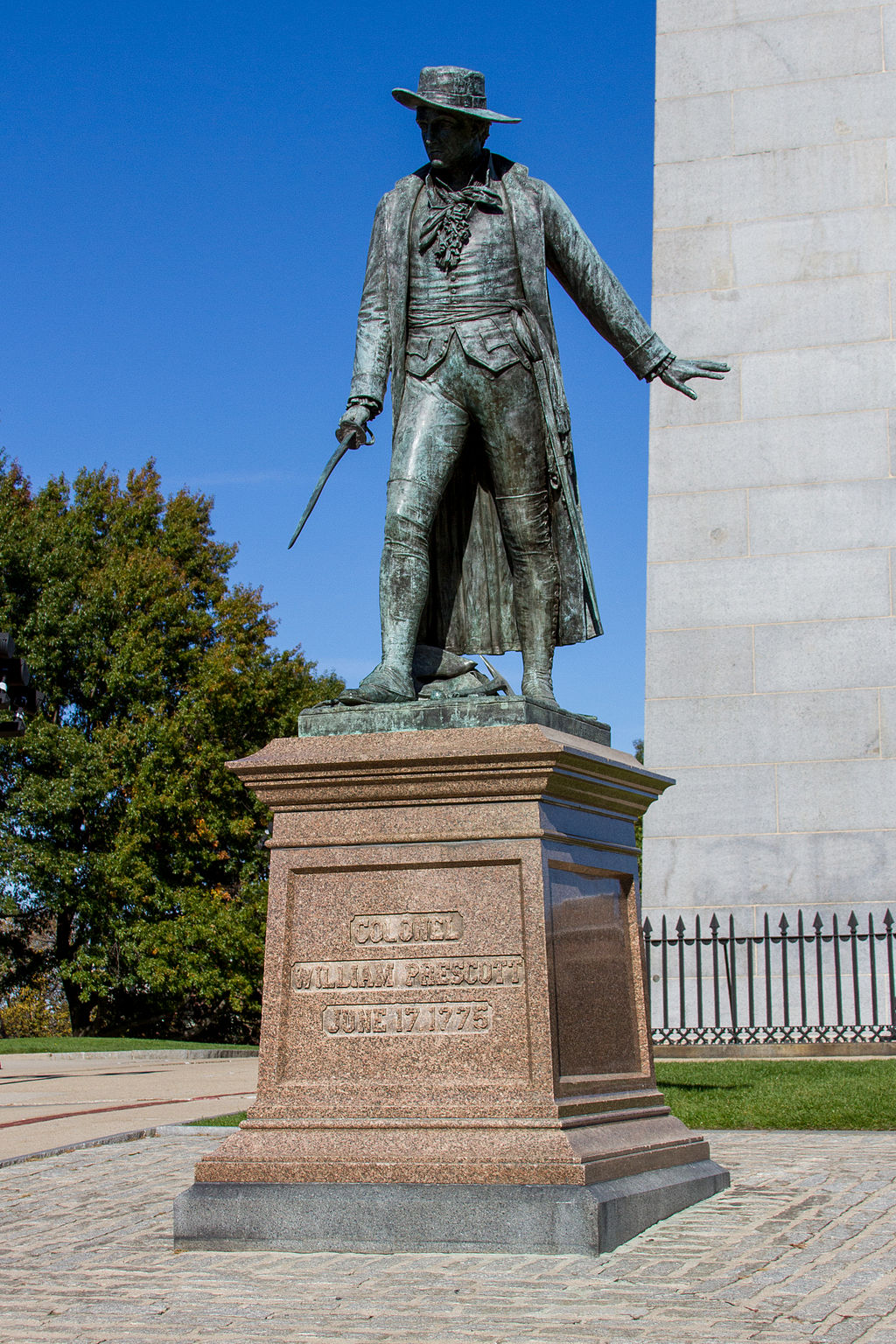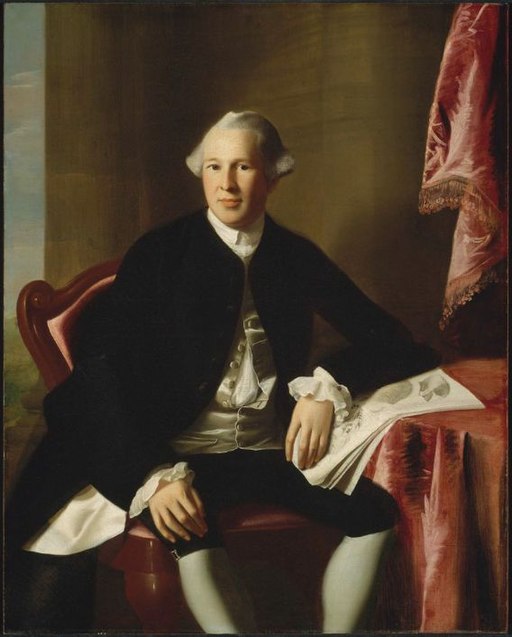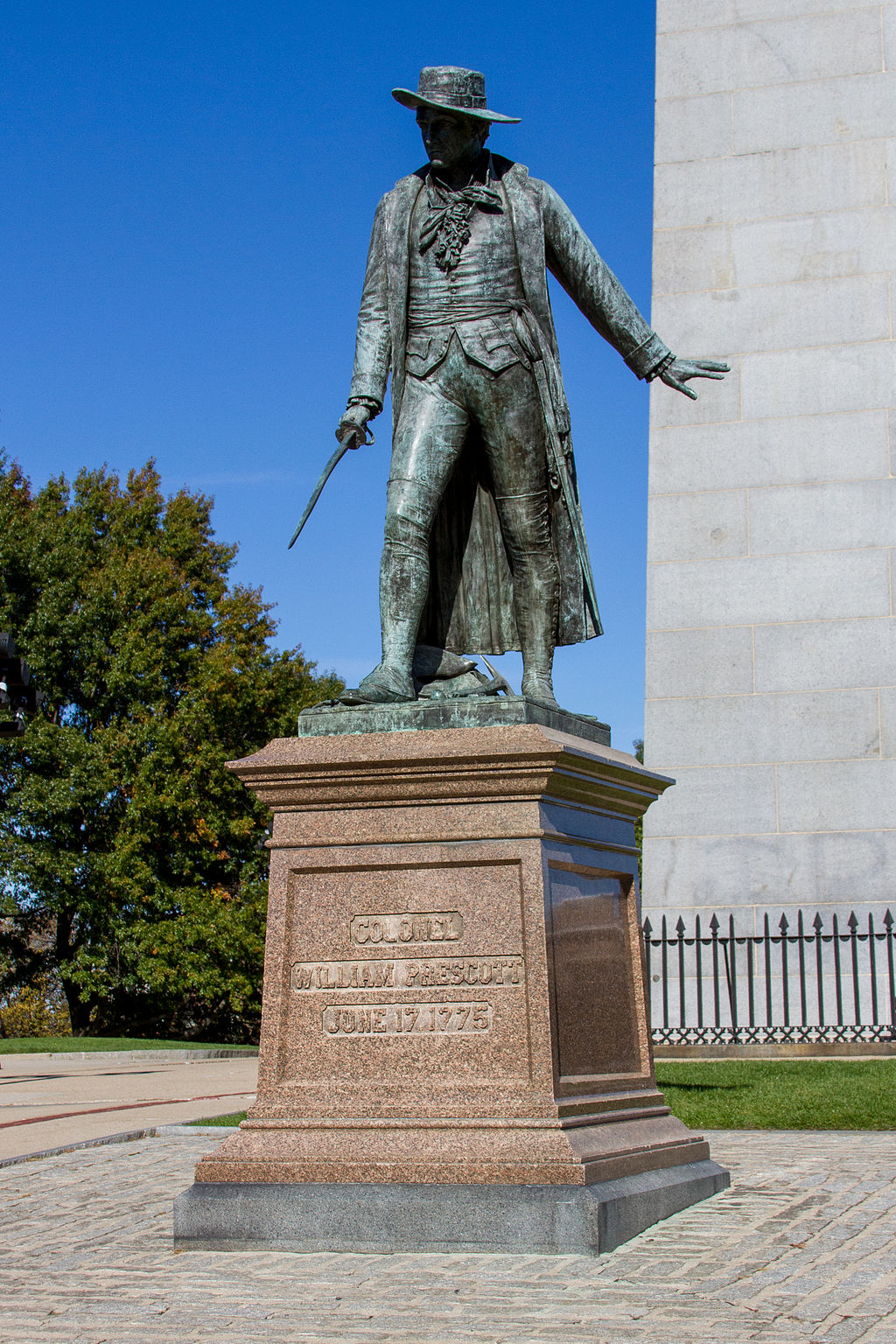The Battle of Bunker Hill
The granite obelisk atop Bunker Hill in Charlestown, commemorates the Battle of Bunker Hill. On June 17, 1775, hundreds of colonial militia and British soldiers fought and died during the first major battle of the American Revolution. While the Colonial patriots were defeated, they proved they could hold their own against the superior British Army. Among the defenders were several enslaved and free Africans and numerous members of the indigenous population as well. The violent clash of these forces signaled that the colonial revolt would not be easily extinguished.*
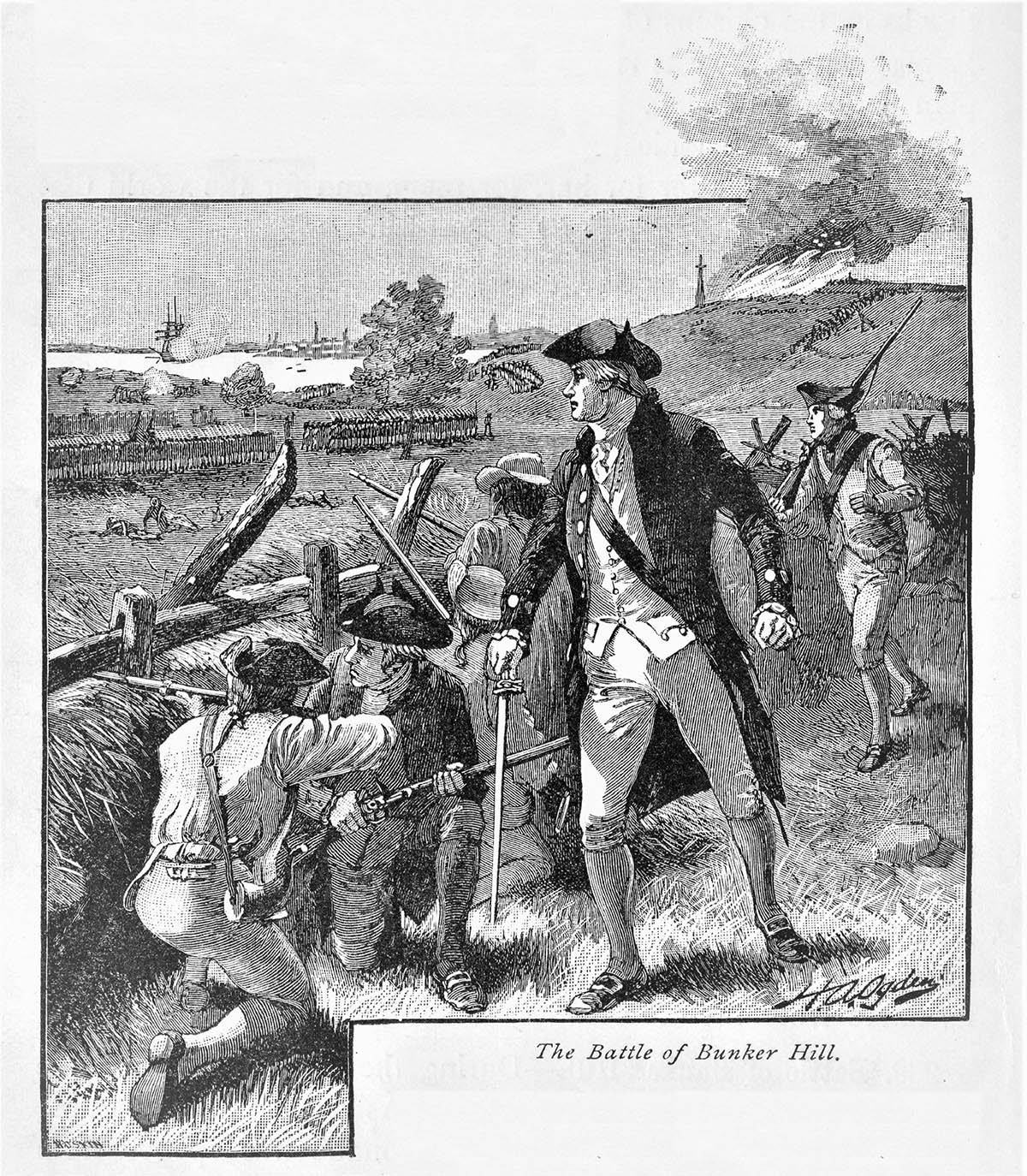
Bunker Hill battle, the siege of Boston, Massachusetts during American Revolutionary War, June 17, 1775. Illustration published in The New Eclectic History of the United States by M. E. Thalheimer (American Book Company; New York, Cincinnati, and Chicago) in 1881 and 1890. Copyright expired; artwork is in Public Domain.
The story of the Bunker Hill Monument
The story of the Bunker Hill Monument is a tale of patriotism, persistence, and the challenges of public funding in early America.
The monument stands as a tribute to the 1775 Battle of Bunker Hill, an early and pivotal conflict in the American Revolutionary War. Yet, its creation was far from a straightforward process; it required years of effort, the dedication of civic-minded individuals, and a series of creative fundraising initiatives.
The Vision and Early Struggles
The idea for the Bunker Hill Monument emerged in the early 19th century, a time when many Americans were looking to commemorate the achievements of the Revolutionary generation. The Bunker Hill Monument Association (BHMA) was founded in 1823 specifically to raise funds for this monument. Prominent figures, including famed orator Daniel Webster, joined the BHMA’s cause and helped raise awareness. Webster’s powerful speeches, celebrating the ideals of liberty and valor, inspired the public and lent credibility to the project.
The BHMA’s Initial efforts led by individual donations and events, such as public speeches and gatherings, which brought in a modest but steady stream of funds. In 1825, during the fiftieth anniversary of the Battle of Bunker Hill, the cornerstone of the monument was laid amid great fanfare, with Webster himself delivering an impassioned address to a crowd of thousands. However, despite this momentous start, the association quickly found itself strapped for cash, with only a fraction of the funds needed to complete the ambitious 221-foot obelisk.
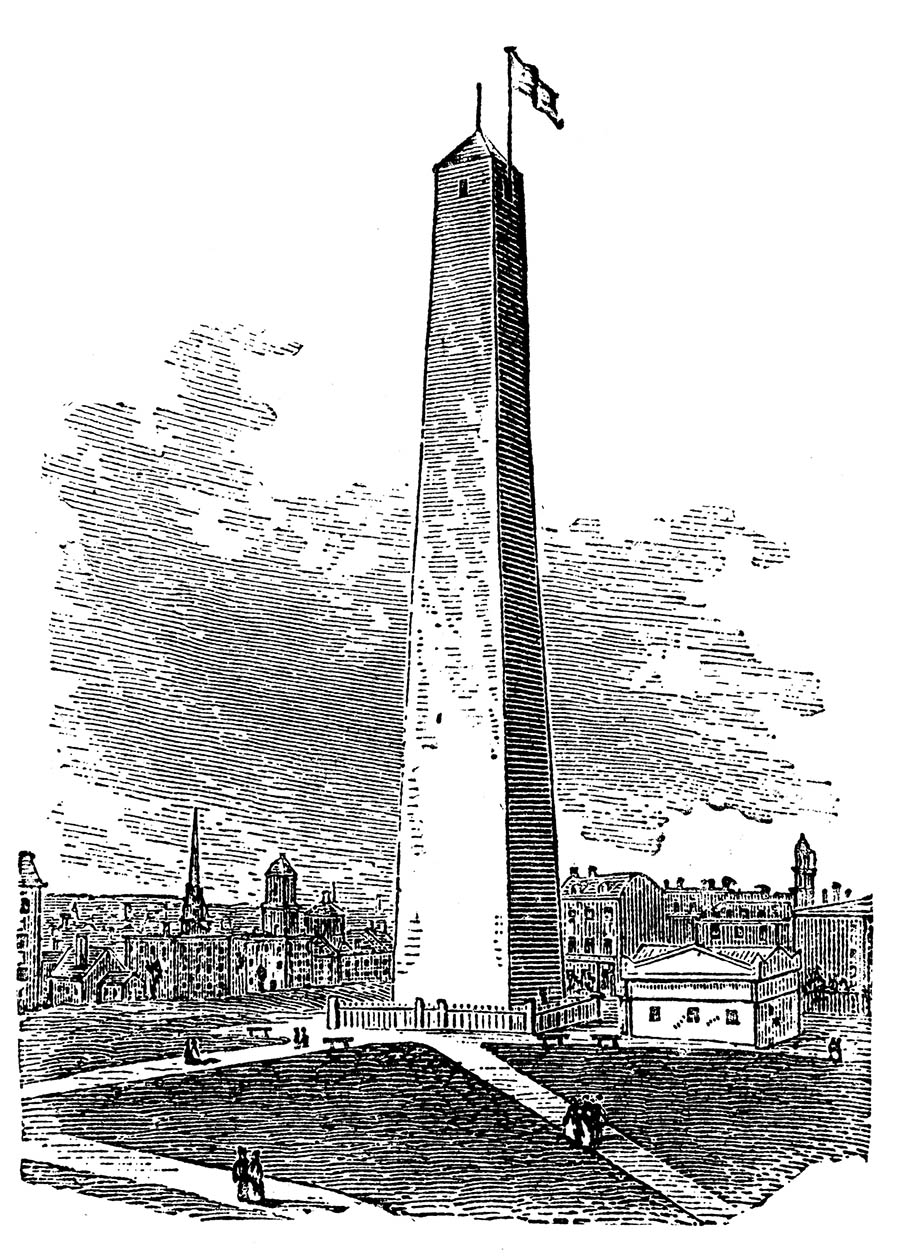
Antique illustration of Bunker Hill Monument
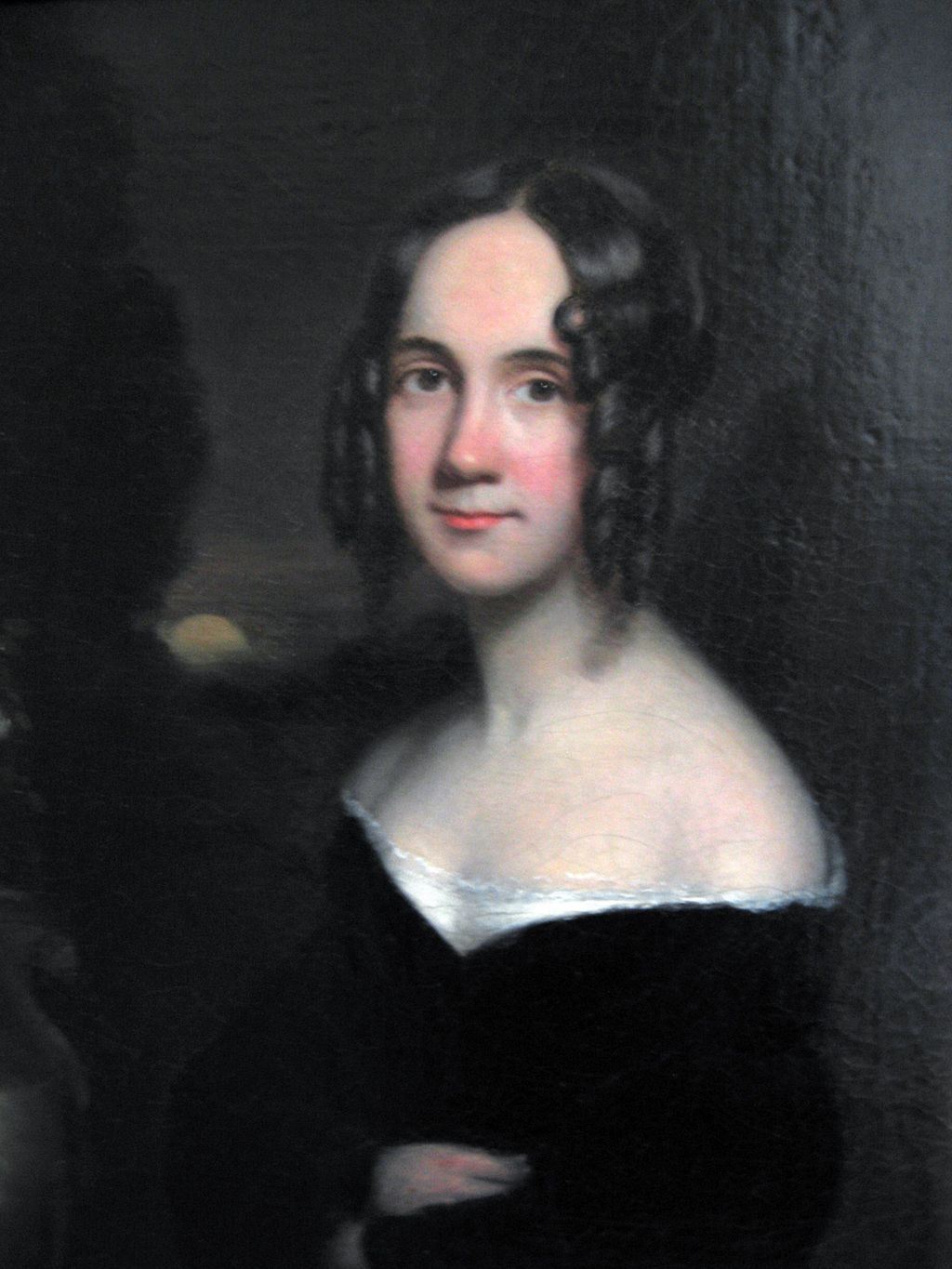
Creative Fundraising: Fairs, Raffles, and Land Sales
Determined not to let the project stall, the BHMA turned to more innovative fundraising methods. The BHMA began selling off parcels of land surrounding the battlefield where much of the Battle of Bunker Hill took place. While controversial, the land sales brought in necessary funds. However, progress remained slow, and construction halted several times due to lack of money, leaving the partially completed obelisk standing as a stark reminder of unfulfilled dreams.
In July of 1840 the BHMA agreed to let Sara Josepha Hale organize one of the first “fairs” in the United States—a massive, multi-day event in which items were donated by citizens, craftsmen, and artisans. Women, led by Sara Josepha Hale, played a significant role in this fair, showcasing crafts and homemade goods to sell to patriotic attendees. Fortunately, Sarah Josepha Hale, the editor and publisher of Godey’s Ladies Book a ladies literary magazine saw the opportunity to enlist woman in the quest to complete the Monument. On September 8th, 1840, for 7 days, the Ladies Fair was held at Quincy’s Market and raised $33,035. The fair proved wildly successful, netting over $30,000, a considerable sum for the time, which helped push the project closer to completion.
The Final Push: From Civic Pride to Personal Appeals
Even with the success of the Fair the project had stalled yet again. Desperate, the BHMA turned to wealthy individuals and prominent civic leaders for personal donations. A new round of public appeals ensued, with Webster and others making renewed calls to Boston’s elite and the public. The BHMA eventually secured funding from Boston entrepreneur Amos Lawrence, who donated $10,000, and philanthropist Judah Touro, who provided an additional $10,000 with the stipulation that Bostonians would contribute a matching amount. These final donations proved enough.
By 1843, the Bunker Hill Monument was complete, and an inauguration ceremony took place marking the end of a nearly two-decade journey to memorialize the bravery and sacrifices of 1775. Over 100,000 people attended the event which was led by The Marquis de Lafayette who helped the Patriots overcome the British forces during the Revolutionary War. Daniel Webster gave the oration. The Grand Master of the Grand Lodge of Massachusetts, the Ancient Free and Accepted Masons led the memorial service. Reverend Joseph Thaxter who was wounded in the battle offered a prayer including 190 Veterans who participated in the Battle of Bunker Hill.
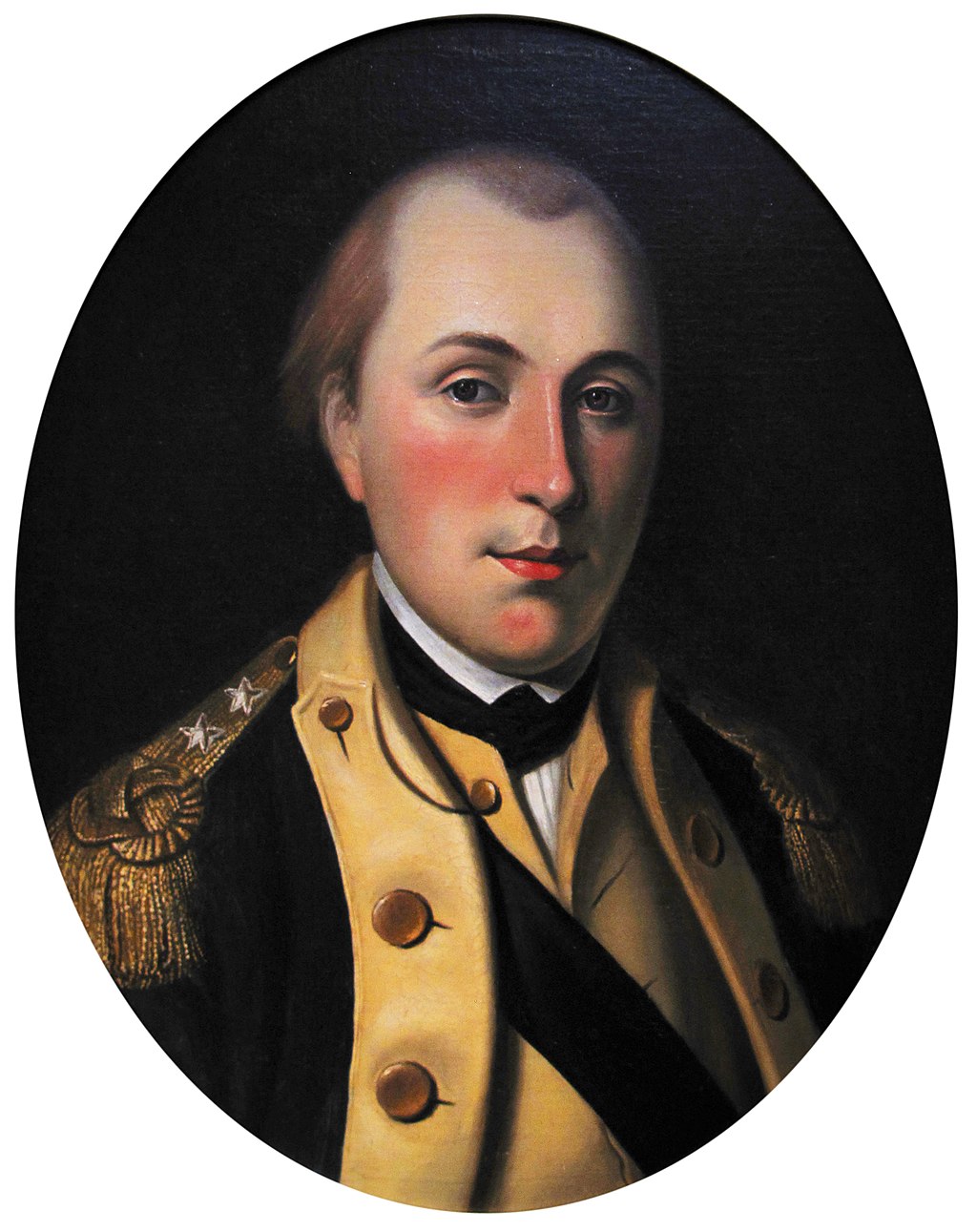
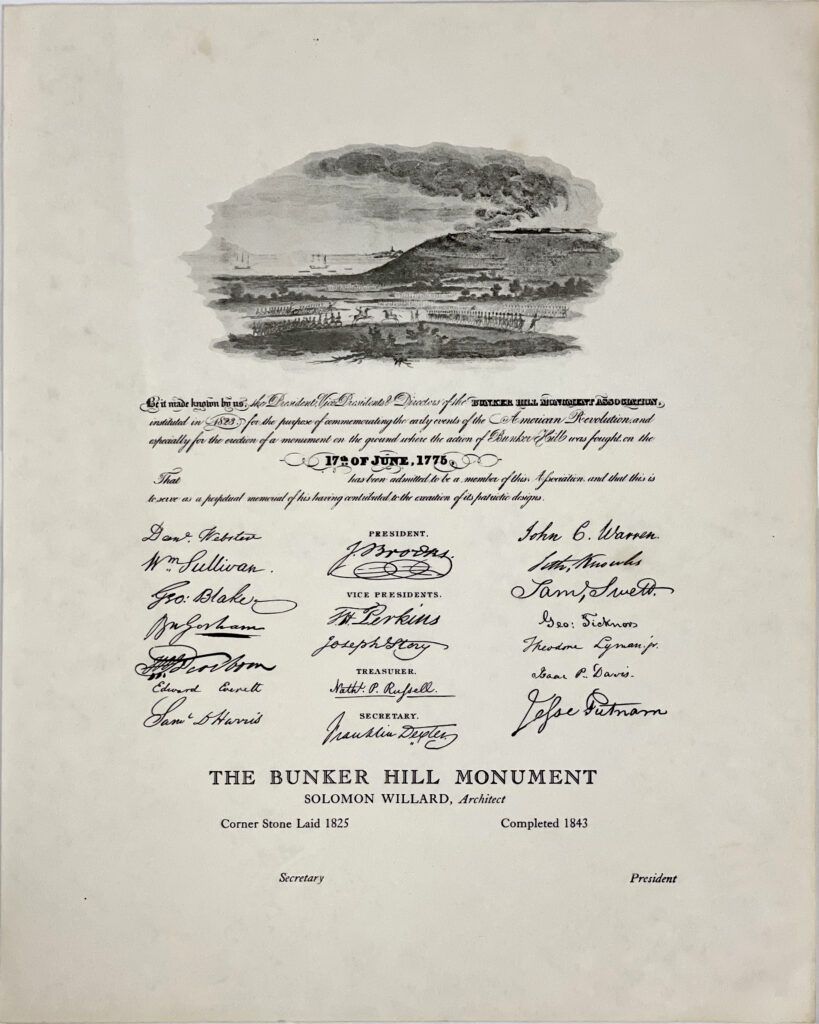
The Bunker Hill Monument Association
The monument would not be here today without the efforts of the BHMA. They initiated the idea of a memorial. They created the design competition, selected the design and architect. BHMA selected the superintendent and oversaw the construction all while scrambling to raise donations, which were often as small as 25 cents.

It took 16 years to complete the construction of the Bunker Hill Monument. Once the construction was completed the BHMA oversaw the daily operations of collecting fees, maintaining the grounds and sharing with the public the rich history of the Battle of Bunker Hill to keep it alive through annual commemorations.
Legacy and Impact
The Bunker Hill Monument’s construction embodied the challenges and triumphs of early American public works. Its eventual completion was not only a tribute to those who fought but also a symbol of community determination, civic pride, and the power of collective fundraising. Through fairs, donations, land sales, and personal appeals, the obelisk now stands as a testament to a nation’s gratitude—and to the tireless efforts of those who believed its creation was essential for honoring America’s past.
Bunker Hill Lodge
The Bunker Hill Lodge serves as a gateway for visitors before they climb the Bunker Hill Monument.
“A little bit of Athens on the Bunker Hill Monument Grounds is the pleasing picture presented by the new lodge of solid masonry and artistic Grecian columns which is now completed.”
—from the Charlestown Enterprise, September 6, 1902
If you visit the Bunker Hill Monument in Charlestown, you will see a building that resembles a Greek temple. The Bunker Hill Lodge, opened in 1902. This structure resembles a Greek temple both inside and out. Antiquity architecture inspired the designs of many buildings constructed during the early years of the new country. Americans particularly liked the Greek Revival style; this style influenced the construction of the U.S. capitol building, which began in 1793.
Staff of the National Parks of Boston, part of the National Park Service (NPS), operates the Bunker Hill Monument and Lodge. The NPS is the third caretaker of this complex, whose history dates to 180 years ago. The Bunker Hill Monument Association (BHMA), a patriotic citizens group, and the Commonwealth of Massachusetts have also served as caretakers.
The BHMA built the obelisk as a memorial to the Battle of Bunker Hill and to the Provincial militia that fought in the battle. They also built the obelisk as a tourist attraction. The BHMA asked the monument’s architect, Solomon Willard, to build an internal, spiral granite staircase from the bottom to the top of the monument. At the top of the monument, they also requested four windows, which provided a panoramic view of the surrounding area.
Today, the Bunker Hill Lodge continues to serve as a gateway for visitors before they climb the Bunker Hill Monument.
If you visit the Bunker Hill Monument in Charlestown, Massachusetts, you’ll see two buildings that resemble ancient forms: an Egyptian obelisk (the Monument) and a Greek temple. The Bunker Hill Lodge, which opened in 1902, resembles a Greek temple both inside and out. Antiquity architecture inspired the designs of many buildings constructed during the early years of the new country.

Swampyank photographed this image of the Masonic building at the base of the Bunker Hill Monument in Charestown, Massachusetts on Jan. 28, 2008.
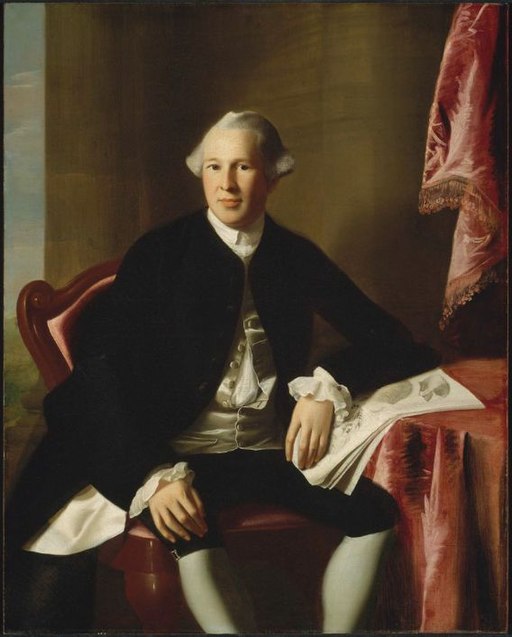
General Joseph Warren
General Joseph Warren died at the Battle of Bunker Hill. He was a founding father of the United States, a physician, and one of the most important figures in the Patriot movement in Boston. Defending the Patriot redoubt against two failed attacks by British troops, he kept firing his gun until running out of ammunition and was killed in action during the third and final assault by British gunfire. There are at least four statues of Joseph Warren on public display, including the exhibit lodge adjacent to the Bunker Hill Monument. There is another on the grounds of the Roxbury Latin School, which he attended as a student and later as a teacher. Many streets, and counties have a Warren County named after him.
The story of the Bunker Hill Monument is a tale of patriotism, persistence, and the challenges of public funding in early America. The monument stands as a tribute to the 1775 Battle of Bunker Hill, an early and pivotal conflict in the American Revolutionary War. Yet, its creation was far from a straightforward process; it required years of effort, the dedication of civic-minded individuals, and a series of creative fundraising initiatives
Colonel William Prescott Statue
Colonel William Prescott holds a significant place in American Revolutionary history for his leadership during the Battle of Bunker Hill.
On June 16, 1775, as tensions with British forces reached a boiling point, Prescott was appointed to lead colonial forces in fortifying Breed’s Hill, mistakenly referred to as Bunker Hill, in Charlestown, Massachusetts. Prescott’s command was instrumental in preparing the colonial defenses on the hill, an act that would set the stage for one of the Revolution’s earliest and most iconic battles. Though his forces were outnumbered and less experienced than the British troops, Prescott’s leadership proved crucial in rallying the colonial militia to stand firm against a formidable enemy.
One of Prescott’s most famous moments came during the heat of battle when he reportedly instructed his men, “Don’t fire until you see the whites of their eyes!” This command underscored his strategic understanding of the situation: the colonists had limited ammunition, and precision was essential to their defense. His focus on conserving fire allowed the colonial forces to inflict significant casualties on the British, creating a psychological impact that boosted American morale. Despite ultimately losing ground at Breed’s Hill, Prescott and his men demonstrated that the colonial forces could stand up to British regulars. This battle, though technically a British victory, marked a turning point in the conflict, giving the American forces confidence in their ability to resist.
The statue of Colonel Prescott at the Bunker Hill Monument in Charlestown honors his bravery, leadership, and tactical acumen. As a reminder of his legacy, the statue stands not only as a tribute to Prescott but also to the spirit of resistance that characterized the American Revolution. His role at Bunker Hill set an example for other leaders in the Revolutionary War, showing that strategic resilience, even in the face of overwhelming odds, could alter the course of history.
